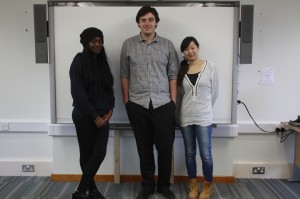![digital-communications-laptop-computer-monitor-screen-mac-pc-free-stock-vector[1]](https://blogs.reading.ac.uk/opal/files/2014/03/digital-communications-laptop-computer-monitor-screen-mac-pc-free-stock-vector1-300x139.jpg) This week I went to an excellent lecture/session, given by Jane Ward, on the process of acquiring listening skills when learning a second language. The research she is undertaking is based on psycholinguistics, studying the ability of learners of foreign languages to decode and parse speech. When we listen to other languages that we don’t know, what we hear is a torrent of sounds (see Enza’s introduction to “grammaring” in OpAL). At some point in that torrent of sounds we start identifying units of meaning, i.e. words. In the process of understanding, learners use a whole array of cognitive and metacognitive strategies that we, the language teachers need to bear in mind when facilitating their language learning experience.
This week I went to an excellent lecture/session, given by Jane Ward, on the process of acquiring listening skills when learning a second language. The research she is undertaking is based on psycholinguistics, studying the ability of learners of foreign languages to decode and parse speech. When we listen to other languages that we don’t know, what we hear is a torrent of sounds (see Enza’s introduction to “grammaring” in OpAL). At some point in that torrent of sounds we start identifying units of meaning, i.e. words. In the process of understanding, learners use a whole array of cognitive and metacognitive strategies that we, the language teachers need to bear in mind when facilitating their language learning experience.
The above studies highlight the need for vocabulary building from a different perspective to the traditional approach. Learning how to improve listening skills is an area that needs much work. Listening is a reception skill that enables the student to produce the language orally at a later stage. If students don’t learn words (I will not go into grammatical or syntactical categories yet) they will not progress in their understanding of the language nor in the correct production of it. For students to improve their listening skills they need to improve their vocabulary first; this does not just involve reading and writing the words to memorize them. Students need to hear how the written words sound in order to recognize them when they are produced by speakers. That can be difficult if they don’t have the help of a native speaker. The use of online bilingual (and monolingual) dictionaries can certainly help students in this area. Sites such as www.collinsdictionary.com or sites such as www.spanishdict.com offer the sound as well as the meaning of the word. Students can then get acquainted with the new piece of vocabulary at two different levels, the written and the aural. We are all very familiar with reading written texts; we can read them at leisure, underline, find a dictionary and check the meanings. With oral texts, particularly if they are produced by a set of native speakers in real time; the experience of trying to make sense of the conversation can be daunting for learners. The more we expose students to means by which they can match sounds with meanings the more we equip them to be successful in their language learning journey.
In a recent survey we conducted with our students, it emerged that the majority use bilingual online dictionaries. We encourage students to use dictionaries to find meanings, but we don’t encourage them to look those words up and listen to them at the same time. Online dictionaries have the advantage of providing the sound file, an advantage that has not always been highlighted. With OpAL we are trying to point these tools and their uses to students. Learning a language does not need to be a difficult and fragmented experience.
Pilar Gray Carlos
 Ayuko has been contributing to our introduction to the Open Access to Languages project on creating materials to facilitate learning a language. She, Luke and Michelle, have been contributing as part of PLanT in creating materials to explain and guide students in the use of bilingual dictionaries and translation tools. She has created a presentation with Prezzi giving some tips and examples on use and missuse of the dictionary and of online translation. Her experience working for the project in her own words: ” My work was creating an activity to practise using online dictionaries and translation tools from Spanish to English. The main objective of the activity is to become aware of using or quoting carefully the meanings found in dictionaries and translations. My experience of learning languages motivated me to join the project. I had a dilemma; I could not explain what I wanted to say even though I used the dictionary, because I did not consider whether the meanings I found in the dictionary were suitable for the contexts. Through
Ayuko has been contributing to our introduction to the Open Access to Languages project on creating materials to facilitate learning a language. She, Luke and Michelle, have been contributing as part of PLanT in creating materials to explain and guide students in the use of bilingual dictionaries and translation tools. She has created a presentation with Prezzi giving some tips and examples on use and missuse of the dictionary and of online translation. Her experience working for the project in her own words: ” My work was creating an activity to practise using online dictionaries and translation tools from Spanish to English. The main objective of the activity is to become aware of using or quoting carefully the meanings found in dictionaries and translations. My experience of learning languages motivated me to join the project. I had a dilemma; I could not explain what I wanted to say even though I used the dictionary, because I did not consider whether the meanings I found in the dictionary were suitable for the contexts. Through



![digital-communications-laptop-computer-monitor-screen-mac-pc-free-stock-vector[1]](https://blogs.reading.ac.uk/opal/files/2014/03/digital-communications-laptop-computer-monitor-screen-mac-pc-free-stock-vector1-300x139.jpg)
